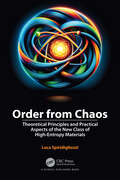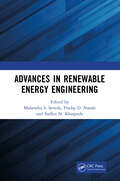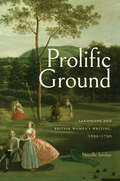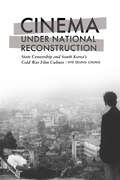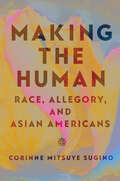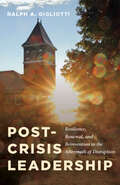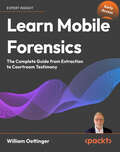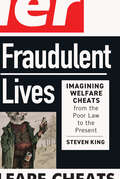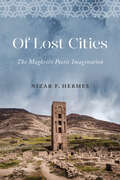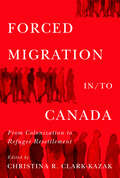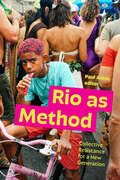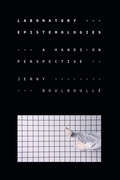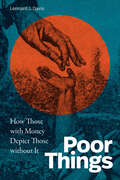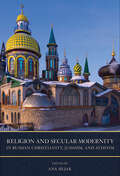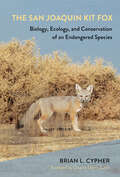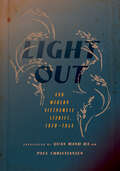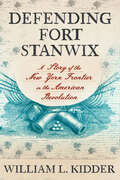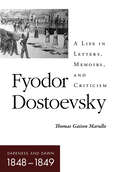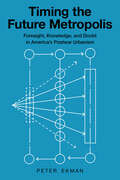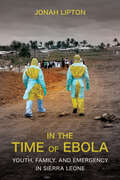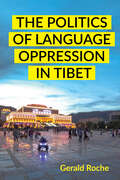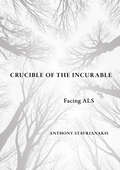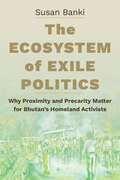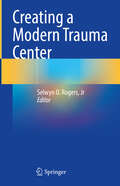- Table View
- List View
Order from Chaos: Theoretical Principles and Practical Aspects of the New Class of High-Entropy Materials
by Luca Spiridigliozzi"Order from Chaos: Theoretical Principles and Practical Aspects of the New Class of High-Entropy Materials" offers a comprehensive exploration of High-Entropy Materials, a novel class of materials characterized by complex compositions and unexpected properties. The book delves into the fundamental principles underlying the formation and stabilization of differently structured High-Entropy Ceramics, presenting a detailed analysis of their main physical and technological properties. Moreover, the book discusses the challenges and future prospects of High-Entropy Ceramics as well as their potential applications in various industrial sectors, making it a useful resource for researchers and engineers in the field of advanced ceramics.
Advances in Renewable Energy Engineering
by Mahendra S. Seveda Pradip D. Narale Sudhir N. KharpudeThis book on Renewable Energy Engineering consolidates the most recent research on current technologies, concepts and commercial developments in the field. It provides an overview of renewable energy engineering practices and technologies and details important concepts like designing of solar photovoltaic system, solar thermal systems, solar water pumping system, solar greenhouse, fuel cell technology, hydro power, wind energy technology, bioenergy, geothermal energy, etc.The subject matter is designed keeping in view the course curricula prescribed by central and state universities in India and abroad, and this book is aimed at students, researchers, academicians, scientists, teachers, policy makers, entrepreneurs, extension workers professionals and experts.Print edition not for sale in South Asia (India, Sri Lanka, Nepal, Bangladesh, Pakistan or Bhutan)
Rutgers Then and Now: Two Centuries of Campus Development: A Historic and Photographic Odyssey
by James W. Hughes David Listokin Richard L. EdwardsRutgers University has come a long way since it was granted a royal charter in 1766. As it migrated from a parsonage in Somerville, to the New Brunswick-sited Sign of the Red Lion tavern, to stately Old Queens, and expanded northward along College Avenue, it would both compete and collaborate with the city that surrounded it for room to grow. Rutgers, Then and Now tells this story, proceeding through ten sequential development phases of College Avenue and Piscataway campus expansions—each with its own buildings and physical layouts—that took place over the course of 250 years. It delivers stunning photographic and historic documentation of the growth of the university, showing “what it was and appeared originally” versus “what it is and looks like today.” Among other in-depth analyses, the book compares the diminutive geographic scale of today’s historical College Avenue Campus—once the entirety of Rutgers—to the much larger-sized (in acreage) Busch Campus. Replete with more than 500 images, the book also considers the Rutgers campuses that might have been, examining plans that were changed or abandoned. Shedding light on the sacrifices and gifts that transformed a small college into a vital hub for research and beloved home for students, it explores how Rutgers grew to become a world-class university.
Prolific Ground: Landscape and British Women's Writing, 1690–1790 (Transits: Literature, Thought & Culture, 1650-1850)
by Nicolle JordanLand ownership—and engagement with land more generally—constituted a crucial dimension of female independence in eighteenth-century Britain. Because political citizenship was restricted to male property owners, women could not wield political power in the way propertied men did. Given its foundational sociopolitical function, land necessarily generated copious writing that vested it with considerable aesthetic and economic value. This book, then, situates these issues in relation to the historical transformation of landscape under emergent capitalism. The women writers featured herein—including Jane Barker, Anne Finch, Sarah Scott, and Elizabeth Montagu—participated in this transformation by celebrating female estate stewardship and evaluating the estate stewardship of men. By asserting their authority in such matters, these writers acquired a degree of independence and self-determination that otherwise proved elusive.
Cinema under National Reconstruction: State Censorship and South Korea’s Cold War Film Culture
by Hye Seung ChungCinema under National Reconstruction calls for a revisionist understanding of state film censorship during successive Cold War military regimes in South Korea (1961–1988). Drawing upon primary documents from the Korean Film Archive’s digitized database and framing South Korean film censorship from a transnational perspective, Hye Seung Chung makes the case that, while political oppression/repression existed inside and outside the film industry during this period, film censorship was not simply a tool for authoritarian dictatorship. Through such case studies as Yu Hyun-mok’s The Stray Bullet (1961), Ha Kil-jong’s The March of the Fools (1975), and Yi Chang-ho’s Declaration of Fools (1983), the author defines censorship as a dialogical process of cultural negotiations wherein the state, the film industry, and the public fight out a battle over the definitions and functions of national cinema. In the context of Cold War Korea, one cannot fully understand or construct film history without reassessing censorship as a productive feedback system where both state regulators and filmmakers played active roles in shaping the new narrative or sentiment of the nation on the big screen.
Making the Human: Race, Allegory, and Asian Americans (Asian American Studies Today)
by Corinne Mitsuye SuginoFrom the debate over affirmative action to the increasingly visible racism amidst the COVID-19 pandemic, Asian Americans have emerged as key figures in a number of contemporary social controversies. In Making the Human: Race, Allegory, and Asian Americans, Corinne Mitsuye Sugino offers the lens of racial allegory to consider how media, institutional, and cultural narratives mobilize difference to normalize a white, Western conception of the human. Rather than focusing on a singular arena of society, Sugino considers contemporary sources across media, law, and popular culture to understand how they interact as dynamic sites of meaning-making. Drawing on scholarship in Asian American studies, Black studies, cultural studies, communication, and gender and sexuality studies, Sugino argues that Asian American racialization and gendering plays a key role in shoring up abstract concepts such as “meritocracy,” “family,” “justice,” “diversity,” and “nation” in ways that naturalize hierarchy. In doing so, Making the Human grapples with anti-Asian racism’s entanglements with colonialism, antiblackness, capitalism, and gendered violence.
Post-Crisis Leadership: Resilience, Renewal, and Reinvention in the Aftermath of Disruption
by Ralph A. GigliottiGiven the many pressures facing leaders across higher education, the work of crisis leadership remains an imperative for leaders at all levels. Attention tends to center on strategies for engaging in leadership both prior to and during crisis, often leaving the post-crisis period as an afterthought. This book introduces a research-informed framework for this critical, and often neglected, phase of crisis leadership. With an underlying commitment to values-based, principle-oriented, and people-centered practices, this framework consists of five leadership practices that are recognized as especially critical in the aftermath of crisis: (a) encourage learning, (b) inspire growth, (c) stimulate meaning-making, (d) pursue reinvention, and (e) advance renewal. Communication serves a critical role in each of the various dimensions of post-crisis leadership, and it is a communication orientation that can help to inform the paradoxes, processes, and patterns that arise during these periods of immense tension and, at times, transcendence.
Learn Mobile Forensics: The Complete Guide from Extraction to Courtroom Testimony
by William OettingerPractical guidance on evidence acquisition, from physical images to logical backups, using open-source tools and leading commercial solutionsKey FeaturesDelve into iOS and Android internals, grasping file systems, database formats, and app data storage for deep mobile forensics understandingMaster advanced decoding for social media, messaging, email, and geolocation appsReinforce skills with hands-on exercises for confident, court-ready reportsBook DescriptionUnlock the secrets hidden within smartphones and tablets with "Learn Mobile Forensics," an indispensable guide providing end-to-end coverage of techniques and tools for extracting and analysing evidentiary data from iOS and Android devices. This practical handbook is designed for forensic examiners, computer security professionals, researchers, and anyone seeking a deeper understanding of mobile internals. Distinguishing itself from other resources, this book focuses on decoding and extracting artifacts from mobile applications. It goes beyond surface-level overviews, offering advanced instructions for interpreting database files and artifacts associated with popular apps. The guide also dedicates an entire chapter to critical legal and ethical considerations, providing clear guidance on maintaining evidentiary integrity and handling personal data ethically. Whether you are assessing WhatsApp message databases or extracting geolocation tracks from Facebook, "Mobile Forensics" equips you with specialized techniques to uncover crucial app forensic evidence. Stay ahead in the evolving field of mobile forensics with this comprehensive and practical guide.What you will learnExplore iOS and Android internals, understanding file systems and app data storage for mobile forensicsDevelop investigative skills through hands-on exercises for court-ready analysis reportsNavigate legal and ethical considerations, ensuring guidelines adherence in mobile forensicsCreate investigation reports that document forensic findings and procedures comprehensively for legal proceedingsAcquire specialized techniques for interpreting database files and artifacts from diverse mobile applicationsWho this book is forThis book is for forensic examiners with basic experience in mobile forensics or open-source solutions for mobile forensics. Computer security professionals, researchers, or anyone looking to gain a deeper understanding of mobile internals will also find this book useful. Understanding digital forensic practices will be helpful to grasp the concepts covered in the book more effectively.
Fraudulent Lives: Imagining Welfare Cheats from the Poor Law to the Present (States, People, and the History of Social Change #9)
by Steven KingThe Western welfare state model is beset with structural, financial, and moral crises. So-called scroungers, cheats, and disability fakers persistently occupy the centre of public policy discussions, even as official statistics suggest that relatively small amounts of money are lost to such schemes.In Fraudulent Lives Steven King focuses on the British case in the first ever long-term analysis of the scale, meaning, and consequences of welfare fraud in Western nations. King argues that an expectation of dishonesty on the part of claimants was written into the basic fabric of the founding statutes of the British welfare state in 1601, and that nothing has subsequently changed. Efforts throughout history to detect and punish fraud have been superficial at best because, he argues, it has never been in the interests of the three main stakeholders – claimants, the general public, and officials and policymakers – to eliminate it.Tracing a substantial underbelly of fraud from the seventeenth century to today, King finds remarkable continuities and historical parallels in public attitudes towards the honesty of welfare recipients – patterns that hold true across Western welfare states.
Of Lost Cities: The Maghribī Poetic Imagination
by Nizar F. HermesThe poetic memorialization of the Maghribī city illuminates the ways in which exilic Maghribī poets constructed idealized images of their native cities from the ninth to nineteenth centuries CE.The first work of its kind in English, Of Lost Cities explores the poetics and politics of elegiac and nostalgic representations of the Maghribī city and sheds light on the ingeniously indigenous and indigenously ingenious manipulation of the classical Arabic subgenres of city elegy and nostalgia for one’s homeland. Often overlooked, these poems – distinctively Maghribī, both classical and vernacular, and written in Arabic and Tamazight – deserve wider recognition in the broader tradition and canon of (post)classical Arabic poetry. Alongside close readings of Maghribī poets such as Ibn Rashīq, Ibn Sharaf, al-Ḥuṣrī al-Ḍarīr, Ibn Ḥammād al-Ṣanhājī, Ibn Khamīs, Abū al-Fatḥ al-Tūnisī, al-Tuhāmī Amghār, and Ibn al-Shāhid, Nizar Hermes provides a comparative analysis using Western theories of place, memory, and nostalgia.Containing the first translations into English of many poetic gems of premodern and precolonial Maghribī poetry, Of Lost Cities reveals the enduring power of poetry in capturing the essence of lost cities and the complex interplay of loss, remembrance, and longing.
Forced Migration in/to Canada: From Colonization to Refugee Resettlement (McGill-Queen's Refugee and Forced Migration Studies #16)
by Christina R. Clark-KazakForced migration shaped the creation of Canada as a settler state and is a defining feature of our contemporary national and global contexts. Many people in Canada have direct or indirect experiences of refugee resettlement and protection, trafficking, and environmental displacement.Offering a comprehensive resource in the growing field of migration studies, Forced Migration in/to Canada is a critical primer from multiple disciplinary perspectives. Researchers, practitioners, and knowledge keepers draw on documentary evidence and analysis to foreground lived experiences of displacement and migration policies at the municipal, provincial, territorial, and federal levels. From the earliest instances of Indigenous displacement and settler colonialism, through Black enslavement, to statelessness, trafficking, and climate migration in today’s world, contributors show how migration, as a human phenomenon, is differentially shaped by intersecting identities and structures. Particularly novel are the specific insights into disability, race, class, social age, and gender identity.Situating Canada within broader international trends, norms, and structures – both today and historically – Forced Migration in/to Canada provides the tools we need to evaluate information we encounter in the news and from government officials, colleagues, and non-governmental organizations. It also proposes new areas for enquiry, discussion, research, advocacy, and action.
Rio as Method: Collective Resistance for a New Generation (Dissident Acts)
by Paul AmarRio as Method provides a new set of lenses for apprehending and transforming the world at critical junctures. Challenging trends that position Global South scholars as research informants or objects, this Rio de Janeiro-based network of scholars, activists, attorneys, and political leaders center their Brazilian megacity as a globally relevant source for transformational world-making insights. Presenting this volume as a handbook and manifesto for energizing public engagement and direct action, more than forty contributors reconceive method as a politics of knowledge production that animates new ways of being, seeing, and doing politics. They draw on lessons from the city’s intersecting religious, feminist, queer, Black, Indigenous, and urbanist movements to examine issues ranging from state violence, urban marginalization, and moral panic to anticorruption efforts, paramilitary policing, sex work, and mutual aid. Rethinking theoretical and collaborative research methods, Rio as Method models theories of decolonial analysis and concepts of collective resistance that can be taken up by scholar-activists anywhere.Contributors. Rosiane Rodrigues de Almeida, José Claudio Souza Alves, Tamires Maria Alves, Paul Amar, Marcelo Caetano Andreoli, Beatriz Bissio, Thaddeus Gregory Blanchette, Fernando Brancoli, Thayane Brêtas, Victoria Broadus, Fatima Cecchetto, Leonard Cortana, Marcos Coutinho, Monica Cunha, Luiz Henrique Eloy Amado, Marielle Franco, Cristiane Gomes Julião, Benjamin Lessing, Roberto Kant de Lima, Amanda De Lisio, Bryan McCann, Flávia Medeiros, Ana Paula Mendes de Miranda, Sean T. Mitchell, Rodrigo Monteiro, Vitória Moreira, Jacqueline de Oliveira Muniz, Laura Rebecca Murray, Cesar Pinheiro Teixeira, Osmundo Pinho, Paulo Pinto, María Victoria Pita, João Gabriel Rabello Sodré, Luciane Rocha, Marcos Alexandre dos Santos Albuquerque, Ana Paula da Silva, Denise Ferreira da Silva, Soraya Simões, Indianare Siqueira, Antonio Carlos de Souza Lima, Leonardo Vieira Silva
Laboratory Epistemologies: A Hands-On Perspective (Experimental Futures)
by Jenny BoulboulléIn Laboratory Epistemologies: A Hands-On Perspective, Jenny Boulboullé examines the significance of hands-on experiences in contemporary life sciences laboratories. Addressing the relationship between contemplation and manipulation in epistemology, Boulboullé combines participant observations in molecular genetics labs and microbiological cleanrooms with a longue durée study of the history and philosophy of science. She radically rereads Descartes’s key epistemological text Meditations on First Philosophy, reframing the philosopher as a hands-on knowledge maker. With this reading, Boulboullé subverts the pervasive modern conception of the disembodied knower and puts the hands-on experimenter at the heart of life sciences research. In so doing, she contributes a theoretical model for understanding how life processes on cellular and molecular levels are manually produced in today’s techno-scientific spaces. By reassessing the Cartesian legacy and arguing that epistemology should be grounded in the standpoint of a hands-on practitioner, Boulboullé offers the philosophical and historical foundation to understand and study contemporary life sciences research as multisensory embodied practices.
Poor Things: How Those with Money Depict Those without It
by Lennard J. DavisFor generations most of the canonical works that detail the lives of poor people have been created by rich or middle-class writers like Charles Dickens, John Steinbeck, or James Agee. This has resulted in overwhelming depictions of poor people as living abject, violent lives in filthy and degrading conditions. In Poor Things, Lennard J. Davis labels this genre “poornography”: distorted narratives of poverty written by and for the middle and upper classes. Davis shows how poornography creates harmful and dangerous stereotypes that build barriers to social justice and change. To remedy this, Davis argues, poor people should write realistic depictions of themselves, but because of representational inequality they cannot. Given the obstacles to the poor accessing the means of publication, Davis suggests that the work should, at least for now, be done by “transclass” writers who were once poor and who can accurately represent poverty without relying on stereotypes and clichés. Only then can the lived experience of poverty be more fully realized.
Religion and Secular Modernity in Russian Christianity, Judaism, and Atheism (NIU Series in Slavic, East European, and Eurasian Studies)
by Edited by Ana SiljakReligion and Secular Modernity in Russian Christianity, Judaism, and Atheism is a multifaceted account of the engagement between religion and the secular in Russia's Christian, Jewish, and atheist traditions. Ana Siljak brings together an interdisciplinary group of leading scholars to present unique perspectives on the secularization dynamic in Russia and the Soviet Union, telling stories about theologians, sects, churches, poets, and artists. From the Jewish Christian priest Alexander Men, to the cross-dressing poet Zinaida Gippius, to the Soviet promoter of Yiddish theater Solomon Mikhoels, Religion and Secular Modernity in Russian Christianity, Judaism, and Atheism gives a voice to a variety of actors who have grappled with the possibilities of faith and unbelief in an industrialized, modern, and seemingly secular world. Now more than ever, as one narrative of Russia's religious history dominates official Russian accounts, alternative perspectives of the relationship between Russian religion and secularism should be highlighted and emphasized.
The San Joaquin Kit Fox: Biology, Ecology, and Conservation of an Endangered Species
by Brian L. CypherThe San Joaquin Kit Fox introduces readers to a small wild canid that occupies a prominent position in ongoing conservation battles. Native to central California, where land is in high demand for development purposes, the San Joaquin kit fox population has been significantly impacted by profound habitat loss. The species remains on the original US endangered species list issued in 1966, with dim prospects for recovery.To guide the work of researchers and conservationists, Brian L. Cypher synthesizes the biological and ecological data collected to date on this species and documents both historical and contemporary efforts to protect it. He details the species' evolutionary and taxonomic history, distribution and habitat preferences, mortality sources, and more. In doing so, he draws out the ever-changing relationship between San Joaquin kit foxes, people, and land use. Richly illustrated and accessible, The San Joaquin Kit Fox is a necessary reference for students, researchers, and conservationists looking to better understand this charismatic creature and others like it in order to better secure the futures of these species.
"Light Out" and Modern Vietnamese Stories, 1930–1954 (NIU Southeast Asian Series)
by Quan Manh Ha Paul Christiansen"Light Out" and Modern Vietnamese Stories, 1930–1954, translated by Quan Manh Ha and Paul Christiansen, with an essay by Ngô Văn Giá, is the first anthology in English of colonial Vietnamese literature written by canonical authors. Light Out depicts colonial exploitation, impoverished peasants at the mercy of precarious crop cycles, and institutionalized corruption that pits peasants against village officials. Set over the course of a few days, the novella presents an intimate look into the rural society in northern Vietnam during the height of French colonialism, exposing the brutal realities of the period and the impact such deprivations have on the human spirit. The eighteen short stories included in this book thematically delineate colonial abuses, class discrimination, patriarchal expectations, and livelihoods tethered to an unstable environment. Aesthetically, they illuminate the impact of French literary traditions and Western thought on Vietnamese traditions of storytelling.
Defending Fort Stanwix: A Story of the New York Frontier in the American Revolution
by William L. KidderIn Defending Fort Stanwix, William L. Kidder tells the dramatic story of "the fort that never surrendered" and the crucial role it played in the American War for Independence. After a series of military defeats over the winter of 1776–1777, British military leaders developed a bold plan to gain control of the Hudson River and divide New England from the rest of the colonies. Three armies would converge on Albany: one under Lieutenant General John Burgoyne moving south from Quebec, one under General William Howe moving north from New York City, and a third under Lieutenant Colonel Barrimore St. Leger cutting east from Lake Ontario along the Mohawk River. Fort Stanwix lay directly on the path of St. Leger's force, making it a key defensive position for the Continental Army. By delaying St. Leger's troops and forcing a retreat, the garrison's stand at Fort Stanwix contributed to Burgoyne's surrender at the Battles of Saratoga a month later, a major turning point in the course of the war.Kidder offers an engaging account of life in and around the fort in the months leading up to the siege, detailing the lives of soldiers and their families, civilians, and the Haudenosaunee peoples with a focus on both the mundane aspects of military life and the courageous actions that earned distinction. Defending Fort Stanwix relates the stories of local men and women, both white and Indian, who helped with the fort's defense before, during, and after the siege and showcases an exciting, overlooked story of bravery and cooperation on New York's frontier during the American Revolution.
Fyodor Dostoevsky–Darkness and Dawn: A Life in Letters, Memoirs, and Criticism (NIU Series in Slavic, East European, and Eurasian Studies)
by Thomas Gaiton MarulloFyodor Dostoevsky—Darkness and Dawn (1848–1849), the third and final volume on the writer's childhood, adolescence, and youth, seeks to disclose, in a detailed and intimate way, Dostoevsky's last two years before his exile to Siberia. Together with the first two volumes, it attempts to present for the first time a complete and congruent picture of the writer's first twenty-eight years. Thomas Gaiton Marullo first examines diverse responses of the Russian church, state, and citizens to the French socialists, in particular, Charles Fourier, and to the revolutions of 1848 before he moves to lively debates on Dostoevsky's socialism and new attacks on his writings. He then considers the dynamics of the Petrashevsky and Durov circles; fresh assaults on Dostoevsky's works; and the increasing desperation of the writer himself, particularly with Andrei Kraevsky. In the final sections of the book, Marullo sheds light on Dostoevsky's readings of Belinsky's letter to Gogol, the arrests of Petrashevsky and company, including Dostoevsky and his brothers, Andrei and Mikhail, as well as his responses to members of the Investigative Commission for the Petrashevsky Affair, his eight months in prison in the Peter-Paul Fortress, his mock execution on the Semyonovsky Parade Ground, and his departure to exile in Siberia.This volume will be of interest to scholars, students, and devotees not only of Dostoevsky, but also of Russian and European history, culture, and civilization.
Timing the Future Metropolis: Foresight, Knowledge, and Doubt in America's Postwar Urbanism
by Peter EkmanTiming the Future Metropolis—an intellectual history of planning, urbanism, design, and social science—explores the network of postwar institutions, formed amid specters of urban "crisis" and "renewal," that set out to envision the future of the American city. Peter Ekman focuses on one decisive node in the network: the Joint Center for Urban Studies, founded in 1959 by scholars at Harvard and MIT. Through its sprawling programs of "organized research," its manifold connections to universities, foundations, publishers, and policymakers, and its years of consultation on the planning of a new city in Venezuela—Ciudad Guayana—the Joint Center became preoccupied with the question of how to conceptualize the urban future as an object of knowledge. Timing the Future Metropolis ultimately compels a broader reflection on temporality in urban planning, rethinking how we might imagine cities yet to come—and the consequences of deciding not to.
In the Time of Ebola: Youth, Family, and Emergency in Sierra Leone
by Jonah LiptonThe anthropologist Jonah Lipton was in Freetown, Sierra Leone, when the largest Ebola outbreak in history hit. In the Time of Ebola is his account of the epidemic, centering on the residents of a neighborhood swept up in the emergency.Lipton follows the lives of young men and women over a period of seven years, revealing what the epidemic looked like on the ground. He explores its causes, impacts, and legacies in a place where crisis might be considered the norm, not the exception. The emergency was disruptive and challenging, not least due to the short-term international response. Yet for many youths Ebola was a time of unusual clarity on the ambiguities around care, work, and coming of age experienced in a context of vast economic and social inequalities. Lipton shows how residents of this historically cosmopolitan West African city drew on centuries-old frameworks for managing foreign intervention. In the Time of Ebola questions dominant framings of crisis and offers ways of theorizing, researching, and responding to emergencies that make the home, the family, and "ordinary life" their starting point.
The Politics of Language Oppression in Tibet
by Gerald RocheIn The Politics of Language Oppression in Tibet, Gerald Roche sheds light on a global crisis of linguistic diversity that will see at least half of the world's languages disappear this century. Roche explores the erosion of linguistic diversity through a study of a community on the northeastern Tibetan Plateau in the People's Republic of China. Manegacha is but one of the sixty minority languages in Tibet and is spoken by about 8,000 people who are otherwise mostly indistinguishable from the Tibetan communities surrounding them. Recently, many in these communities have switched to speaking Tibetan, and Manegacha faces an uncertain future. The author uses the Manegacha case to show how linguistic diversity across Tibet is collapsing under assimilatory state policies. He looks at how global advocacy networks inadequately acknowledge this issue, highlighting the complex politics of language in an inter-connected world. The Politics of Language Oppression in Tibet broadens our understanding of Tibet and China, the crisis of global linguistic diversity, and the radical changes needed to address this crisis.
Crucible of the Incurable: Facing ALS (Expertise: Cultures and Technologies of Knowledge)
by Anthony StavrianakisCrucible of the Incurable concerns how people face life with amyotrophic lateral sclerosis (ALS). Anthony Stavrianakis spent a year in clinics and with people living with the illness in the United States. He examines the multiple meanings of care in a context of a chronic, degenerative, one-hundred percent fatal, neuromuscular illness, whose most common duration is between two and five years. How do people diagnosed with ALS continue to "live as well as possible, for as long as possible" in accordance with the normative work at the heart of outpatient ALS care? Crucible of the Incurable shows how those touched by the situation of a person living with ALS bear this problem and this task. Given the sense of certitude around the diagnosis, given past experiences of those aware of its usual progression, and given the uncertainty of the disease's cause and its progression for each specific person; how then do people orient themselves to the experience of life with this illness, how to support those who are confronted with it, and how to provide aid or solace.
The Ecosystem of Exile Politics: Why Proximity and Precarity Matter for Bhutan's Homeland Activists
by Susan BankiThe Ecosystem of Exile Politics relays the events in Bhutan that led to the exodus of one-sixth of the population, and then recounts the activism by Bhutan's refugee diaspora that followed in response. Susan Banki asserts that activism functions like a physical ecosystem, in which hubs of activism in different locations interact to pressure the home country. For Bhutan's refugee mobilizers, physical proximity offers advantages in Nepal and India, where organizing protests, lobbying, and collecting information about government abuse in Bhutan is aided by being close to the homeland. But in an ecosystem of exile politics, proximity is both a boon and a bane. Sites proximate to Bhutan can be spaces of risk and disempowerment, and refugee activists rarely secure legal, political, and social protection. While distant diasporas in the Global North may not be in precarious situations, they cannot tap into the advantages of proximity. In examining these phenomena, The Ecosystem of Exile Politics adds to theoretical understandings of exile politics and to empirical research on Bhutan and its refugee population.
Creating a Modern Trauma Center
by Selwyn O. RogersViolence and trauma are growing global problems. From the impacts of geopolitical forces to structural violence to the local effects of interpersonal violence, trauma is ubiquitous in our society. Existing trauma systems everywhere are expanding to meet the needs of injured patients. Unfortunately, in some places, adequate resources are not in place to provide modern trauma care. Until very recently, this absence of resources existed on the South Side of Chicago. For three decades, the South Side of Chicago was a relative trauma “desert”. In 2018, the University of Chicago Medicine opened a modern adult trauma center in an area that previously suffered from a relative lack of access to adult trauma care. This book will provide the reader with an understanding of the journey the University of Chicago went through to develop a modern trauma center where there previously was nothing. It will chart a journey through the history on the South Side of Chicago and will provide an understanding of the proper needs assessment that goes into planning a new trauma center. It will describe the implementation of the multi-disciplinary teams needed to provide modern trauma care. It will then describe the effects of this trauma center and its future directions. As many places are struggling with caring for increasing levels of violence, there likely will be a need for others to go through a similar developmental process. Sharing the experience of the University of Chicago Medicine going from a non-trauma hospital to the busiest trauma center in Chicago, we hope that this book will provide some guidance to others and accompany you on one’s journey.
